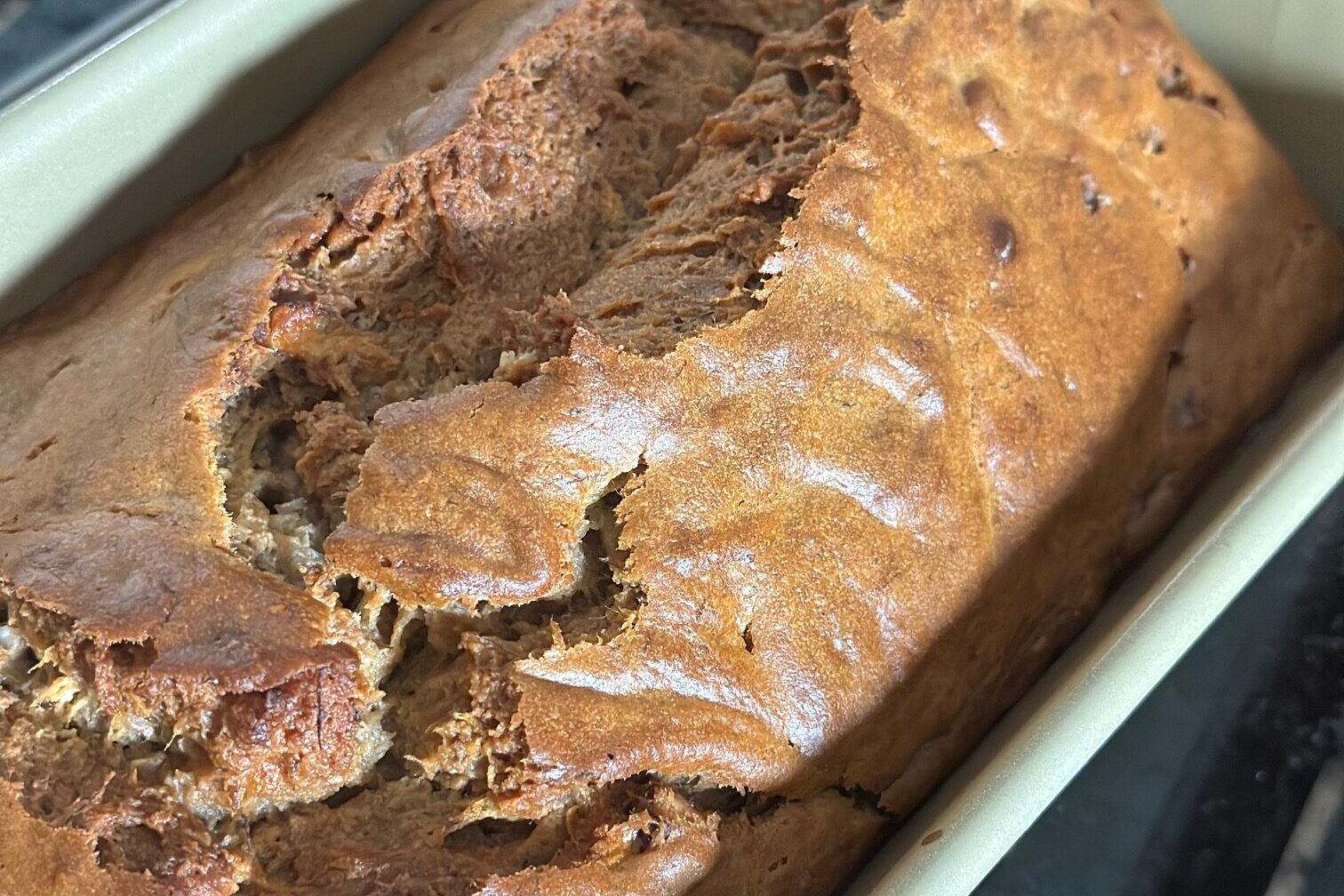I would probably call this challenge the ultimate in baking challenges, at least for me:). After the first pull apart bread, I was all set to turn in my entry to this challenge “on time”, only to discover that Aparna had truly made this a sequel to the “Daring Baker’s Challenge”:). For the uninitiated, that is another group of bakers and as the title suggests the recipes are quite challenging. The recipe for making these croissants is all of 3 pages long and the process takes 3 days. Intimidating and definitely not something I would’ve even bothered to give a second look – those who know me well know how much I love to “cook and get out” – of the kitchen, I mean. But much as I would’ve been rigid in that rule of mine, there does come a time when you know that getting out of that comfort zone and pushing yourself once in a while is what makes life interesting – gives you that rush, that sense of fulfillment. Kinda like managing to finish a 10k. For someone like me who just 14 months ago hated the thought of running – outdoors or indoors. I know, I digress. But to me the two situations were quite similar, and coincidentally happened around the same time, a week apart from each other.
And someone or something does play a major role in pushing all of us. For the run it happened to be my husband Girish who started to run two years ago and got reluctant me into the habit. Now I feel like it has become an addiction of sorts and I’m signing us up for all the running events in the city:). Well sort of.
And Aparna’s group has been that someone and something for pushing me to bake more . I joined the Daring Bakers a year ago and for some reason couldn’t really get into it. It probably didn’t push me enough even if the recipes were equally or more daunting. What’s worked for me here has been Aparna’s concept of a (closed) Facebook group, the daily updates from the 100 or so members, the drooling pictures that make you feel a tad guilty that you are yet another day behind on the challenge – all this has driven me to bake something I would never have dreamed
of a year ago.
In both cases I did learn one thing – nothing is daunting if you plan well and work steadily towards your goal. This recipe looks long but if you read it well and plan it, it’s not all that bad. Yeah I know that sounds cliched. And even if I didn’t think that for a minute while baking them or running those miles, I do now, after I managed to get past the finish line, in both cases:)
Here’s the step by step recipe for Classic Croissants. They were a hit – flaky, soft, layered and just right. Enough to make me feel like a Nigella Lawson, even for a day:)
Ingredients:
For the dough:
4 cups all-purpose flour, and a little more for dusting/ rolling out dough
1/2 cup plus 2 tbsp ice water
1/2 cup plus 2 tbsp cold milk
1/4 cup sugar
40gm soft/melted unsalted butter (about 3 tbsps)
1 tbsp + 1/2 tsp instant yeast
2 tsp salt
For the butter layer:
250 gm cold unsalted butter (~2 sticks + 2 tablespoons)
1/4 cup of milk or mix of milk & heavy cream to brush the rolled croissants
Method:
Day 1:
Make the dough (and refrigerate overnight)
- Combine all the ingredients for the dough in the bowl of a stand mixer fitted with the dough hook. You can also use a food processor with the plastic blade, or do this by hand.

- Mix everything on low speed for 3 minutes, scraping the sides of the mixing bowl once if necessary. Then mix further on medium speed for 3 minutes. Lightly flour a 10-inch pie pan or a dinner plate. And place the ball of dough on this.
- Gently shape the dough into a flat ball by pressing it down before storing it in the fridge, this makes rolling out next morning easier. Making a tight ball will strengthen the gluten which you do not need. Lightly dust the top of the dough with flour and wrap well with plastic so it doesn’t dry out. Refrigerate overnight.

Day 2:
Make the butter layer
- The next day, cut out 2 pieces of parchment or waxed paper into 10” squares each. Cut the cold butter into 1/2-inch-thick slabs. Place these pieces on one piece of parchment/ waxed paper so they form a 5- to 6-inch square. Cut the butter further into pieces as required to fit the square. Top with the other piece of parchment/ waxed paper.
- Using a rolling pin, pound the butter with light, even strokes. As the pieces begin to stick together, use more force. Pound the butter until it flattens out evenly into a square that’s approximately 7-1/2”. Trim the edges of the butter to make a neat square. Put the trimmings on top of the square and pound them in lightly with the rolling pin. Refrigerate this while you roll out the dough.
Laminate the dough
Note – I don’t have great pictures for this as this was the most important step and I really wanted to focus and yes it was also the most messy with the butter and dough:)
- Unwrap and lay the dough on a lightly floured work surface. Roll it out to a 10-1/2-inch square, and brush off the excess flour. Take the butter out from the refrigerator —it should be cold but pliable. If it isn’t refrigerate it till it is. This so that when you roll out the dough with the butter in ti, neither should it be soft enough to melt, or hard enough to break. Unwrap the butter and place it on the square of dough in the center, so that it forms a “diamond” shape on the dough.
- Fold one flap of dough over the butter toward you, stretching it slightly so that the point just reaches the middle of the butter square. Bring the opposite flap to the middle, slightly overlapping the previous one. Similarly repeat with the other two so that the dough forms an envelope around the butter. Lightly press the edges together to completely seal the butter inside the dough to ensure the butter doesn’t escape when you roll out the dough later.
- Lightly flour the top and bottom of the dough. With the rolling pin, firmly press along the dough uniformly to elongate it slightly. Now begin rolling instead of pressing, focusing on lengthening rather than widening the dough and keeping the edges straight.
- Roll the dough into an 8” by 24” rectangle. If the ends lose their square shape, gently reshape the corners with your hands. Brush off the excess flour.Mark the dough lightly equally into three along the long side. Using this as a guideline, pick up one short end of the dough and fold 1/3rd of it back over the dough, so that 1/3rd of the other end of dough is exposed. Now fold the 1/3rd exposed dough over the folded side. Basically, the dough is folded like 3-fold letter before it goes into an envelope (letter fold). Put the folded dough on a floured baking sheet, cover with plastic wrap, and freeze for 15 to 20 minutes to relax and chill the dough.
- Repeat the rolling and folding, this time rolling in the direction of the two open ends (from the shorter sides to lengthen the longer sides) until the dough is about 8” by 24”. Once again fold the dough in thirds, brushing off excess flour and turning under any rounded edges or short ends with exposed or smeared layers. Cover once again with plastic wrap and freeze for another 15 to 20 minutes.
- Roll and fold the dough exactly in the same way for the third time and put it baking sheet. Cover with plastic wrap, tucking the plastic under all four sides and refrigerate overnight.
Day 3:
Divide the dough
- The next day, unwrap and lightly flour the top and bottom of the dough. Cut the dough along the longer side into halves. Cover one half with plastic wrap and refrigerate it while working on the other half.
- “Wake up the dough up” by pressing firmly along its length with the rolling pin. Don’t widen the dough but simply begin to lengthen it with these first strokes. Slowly roll the dough into a long and narrow strip, approximately 8” by 22”. If the dough sticks as you roll, sprinkle with flour.

- Once the dough is about half to two-thirds of its final length, it may start to resist rolling and even shrink back. If this happens, fold the dough in thirds, cover, and refrigerate for about 10 minutes; then unfold the dough and finish rolling.
- Lift the dough an inch or so off the table at its midpoint and allow it to shrink from both sides and prevent the dough from shrinking when it’s cut. Check that there’s enough excess dough on either end so that when you trim the edges to straighten them, you have a strip of dough that is 20’ inches long. Now trim the edges so they’re straight.
- If you’re good at “eyeballing” and cutting the dough into triangles, then forget the measuring rule, marking and cutting instructions. Otherwise, lay a measuring rule or tape measure lengthwise along the top length of the dough. With a knife, mark the top of the dough at 5-inch intervals along the length (there will be 3 marks in all). Now place the rule or tape measure along the bottom length of the dough. Make a mark 2-1/2 inches in from the end of the dough. Make marks at 5-inch intervals from this point all along the bottom of the dough. You’ll have 4 marks that fall halfway between the marks at the top.
- Make diagonal cuts by positioning the yardstick at the top corner and the first bottom mark. Use a pizza wheel/ pie wheel or a bench scraper and cut the dough along this line which connects each top mark to the next bottom mark and then back to the next top mark and so on. This way you will have 7 triangles and a scrap of dough at each end.

Shape the croissants
- Now work with one piece of triangular dough at a time. Using your rolling pin, very lightly roll (do not make it thin but only stretch it slightly) the triangle to stretch it a little, until it is about 10” long. This will give your croissants height and layers. You can stretch it by hand too, but if you don’t have the practice, your stretching could be uneven.
- Using a sharp small knife, make a 1/2- to 3/4-inch-long notch in the center of the short side of each triangle. The notch helps the rolled croissant curl into a crescent.
- Place the triangle on the work surface with the notched side closest to you. With one hand on each side of the notch, begin to roll the dough away from you, towards the pointed end.
- Flare your hands outward as you roll so that the notched “legs” become longer. Roll the triangle tight enough but not too tight to compress it, until you reach the “pointy” end which should be under the croissant.
- Now bend the two legs towards you to form a tight crescent shape and gently press the tips of the legs together (they’ll come apart while proofing but keep their crescent shape).
- Shape all the triangles like this into croissants and place them on a greased or parchment lined baking sheet leaving as much space between them as they will rise quite a bit.

Proof the croissants
- Brush the croissants with milk (or a mix of milk and cream). If you use eggs, make an egg wash by whisking one egg with 1 tsp water in a small bowl until very smooth. Lightly brush this on each croissant.
- Refrigerate the remaining milk/ milk+cream (or egg wash) for brushing the croissants again later. Place the croissants in a cool and draft-free place (the butter should not melt) for proofing/ rising for about 1 1/2 to 2 hours. They might need longer than 2 hours to proof, maybe as much as 3 hours, so make sure to let croissants take the time to proof. The croissants will be distinctly larger but not doubled in size. They’re ready if you can see the layers of dough from the side, and if you lightly shake the sheets, the croissants will wiggle.

Bake the croissants
- Just before the croissants are fully proofed, pre-heat your oven to 200C (400F) in a convection oven or 220C (425F) in a regular oven. Brush the croissants with milk/ milk+cream (or egg wash) a second time, and place your baking sheets on the top and lower thirds of your oven (if regular) or bake one tray at a time in the convection oven.
- Bake them for about 15 to 20 minutes till they’re done and golden brown on top and just beginning to brown at the sides. In a regular oven, remember to turn your baking sheets halfway through. If they seem to be darkening too quickly during baking, lower the oven temperature by 10C (25F). Cool the croissants on the baking sheets on racks.

Serve warm. This recipe makes 15 croissants. I used only half (7) and added some filling to the other half and baked it the next day. I filled some with Punjabi Samosa filling, nutella, and PB&J. PBJ was Nikhil’s creation and it oozed a bit but was yummy nevertheless.
Will post those pictures soon and update this post.
Here’s a link to a great video that gives you the step by step recipe for more clarity.
Link to video on making croissants – http://www.youtube.com/watch?v=Ot3jKnkTfPY&feature=player_embedded





6 Comments
Comments are closed.








i can run but this is wayyyy beyond my ‘standing int he kitchen’ time limit 🙂
however when i visit i will expect this for breakfast and enjoy 😉 and then we can go out for a run to melt all that gobs of butter
I’m going to hold you to that Myth. When are you visiting? I’m all for stuffing my face and then running:)
Croissants look perfect and yumm!
Thanks Rinku! You have a nice blog yourself. Some interesting recipes.
Raj is being asked about s’pore — there’s talk of expat pckg for 2 yrs.. I’m resisting hoping i can restrict it to 1 yr, I don’t want to disrupt Rohan’s high school too much , at the same time i want to live in a s’pore !!!!
We were supposed to go to Seattle and i had even a house scoped out 🙂 pike market yessssss.. but that’s not to be. so lets see. what happens.
it’s a pain to come there , find a job and quit in a yr and come back to hunt here again , but I’m ok with 1 yr thought . Longer than that ,It’s not a wise move with a high school-er …
Just come and stay for a year while we are here:) I will help you look for condos and schools I promise:)